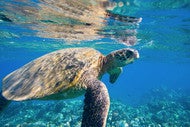Marine National Monuments: Protecting Aquatic Life From Coast to Coast
May 1st 2020
 To protect bodies of water from contamination, assault and harm from other uses that put natural systems at risk, marine monuments and national marine sanctuaries are established. The major distinction between the two lies in the ways they are chosen and the laws that govern their establishment and maintenance.
To protect bodies of water from contamination, assault and harm from other uses that put natural systems at risk, marine monuments and national marine sanctuaries are established. The major distinction between the two lies in the ways they are chosen and the laws that govern their establishment and maintenance.
The Office of National Marine Sanctuaries administrates a group of underwater parks comprised of more than 600,000 square miles. This includes The Great Lakes, waters found in the Florida Keys, waters throughout the state of Washington, as well as American Samoa. The system includes the marine national monuments of Papahanaumokuakea and Rose Atoll along with 13 national marine sanctuaries.
Papahanaumokuakea Marine National Monument
Papahanaumokuakea Marine National Monument—a 1,350-mile string of banks, seamounts, shoals and coral islands—is the biggest contiguous conservation group that has the full protection of the United States. It is one of the most massive marine conservation regions worldwide. It covers a remarkable 582,578 square miles of the Pacific Ocean, a region larger in area than all of America's national parks put together.
This monument encompasses an inconceivable variety of marine mammals, fish, birds, and coral, as well as extensive flora and fauna. Many species are exclusive to the Hawaiian Islands where the shallow waters provide the ideal atmospheres for the endangered green turtle and Hawaiian monk seal, also which are threatened by extinction. An incredible 14 million seabirds of 22 species also breed and nest in the Papahanaumokuakea Marine National Monument. The safeguarded area is also home to four unique species of birds found nowhere else on earth, including the Laysan duck, the most endangered duck in the world.
Rose Atoll Marine National Monument
The Rose Atoll Marine National Monument was founded in January 2009 through a Presidential Proclamation. Rose Atoll is the most eastern Samoan island, as well as the most southern point of America. It's located approximately 130 nautical miles from Pago Pago Harbor, American Samoa.
Rose Atoll's marine environment is the backbone of a forceful reef bionetwork that is residence for a dissimilar group of marine species, a large portion of which are in danger of extinction. One of the most remarkable aspects of Rose Atoll is the distinctive pink color of fringing reef, a hue that results from the perpetuation of coralline algae, the principal reef-building variety. The Rose Atoll reefs are controlled by crustose coralline algae, despite the existence of about 100 categories of stony corals, which renders them unique from reefs commonly found on other Samoan islands.
The marine area boasts much more than breathtaking reefs. It offers remote, serene nesting grounds for hawksbill and green turtles and is home to the largest quantity of nesting turtles found in American Samoa. Rose Atoll also has 272 different species of reef fish, including seven varieties discovered there by local scientists. The monument is one of a handful of comparatively untouched islands worldwide, as well as one of the only enduring sanctuaries for the seabird and turtle classes native to the Central Pacific.

